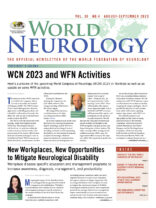Workplace disease-specific education and management programs to increase awareness, diagnosis, management, and productivity.
By Dr. Olivia Begasse de Dhaem

Olivia Begasse de Dhaem
Mitigating the impact of the disability related to neurological diseases goes beyond medical management and rehabilitation. Workplace accommodations and workplace disease education and management programs must be included in the continued efforts of the 2023 World Brain Day campaign.
As stated by Prof. David Dodick on World Brain Day 2023, disability is associated with developing chronic conditions; earlier mortality; disparities in terms of access to care, education, job; stigma; and poverty. Supporting people with neurological disorders in the workplace is crucial to mitigate the downstream impact of disability. Neurological disability interferes with occupational potential and earning, which in turn can negatively impact mental health and access to medical care and worsen the level of disease state and its related disability. Being in the workforce contributes to general and mental health.
Let’s take the example of migraine, the second leading cause of disability in the world according to the Global Burden of Diseases. Migraine is the second cause of presenteeism (being present at work but not as productive as usual due to the symptoms of a disease) in the United States, estimated to account for 16% of total workplace presenteeism and to cost $240 billion (USD) annually. Although the migraine-related productivity loss increases with the frequency of migraine attacks, there is significant productivity loss interictally as 41.5% of workers have moderate to severe interictal symptoms.
Thankfully, there are evidence-based ways to help workers with migraine, such as social support (between colleagues and by supervisor), job satisfaction, a sense of autonomy, and workplace accommodations (such as natural lights, noise reduction, scent-free areas, regular breaks, air quality). Small interventions such as raising awareness in the workplace and helping a supervisor understand the disease can have a huge impact. One patient of the author was about to lose her job as a cashier at a supermarket due to the numerous work absences she had because of her chronic migraine. After discussions and a doctor’s note, her supervisor helped her change her job from cashier to bagger, so instead of constantly rotating her neck to look at a bright screen while scanning, she was placing the groceries in bags. She was also allowed to take regular breaks to lay down on a mat in a dark, quieter closet. These accommodations enabled her to continue working full time with rare absences.
Migraine workplace education and management programs offered to all employees and supervisors increase understanding of the disease, decrease stigma, improve diagnosis and treatment, and increase productivity. It is crucial to educate the entire employee population and not target a specific group.
The Fujitsu Headache Project enrolled 73,432 (91%) of its employees in Japan with a migraine prevalence of 17%. This workplace education and management program improved:
• the understanding of headache disorders (73% of participants)
• the attitude toward colleagues with headache disorders (83% of participants without headache) – productivity
It reduced absences and presentee days by 1.2 and 14 days per employee per year, respectively, with a 32-fold positive return-on-investment.
As workplaces are being redesigned after the COVID-19 pandemic, now is the time for neurologists to advocate for equitable work opportunities for people with neurological diseases and to promote workplace education programs like the International Headache Society Global Patient Advocacy Coalition (IHS-GPAC) Migraine Fitness modules. •
For additional information:
• Begasse de Dhaem O. Migraines are a Serious Problem. Employers Can Help. Harvard Business Review. February 2021.
• Begasse de Dhaem O, Sakai F. Migraine in the workplace. eNeurologicalSci. 2022;27:100408. June 2022.
• Sakai F, Igarashi H, Yokoyama M, Begasse de Dhaem O, et al. Diagnosis, knowledge, perception, and productivity impact of headache education and clinical evaluation program in the workplace at an information technology company of more than 70,000 employees. Cephalalgia. 2023;43(4):3331024231165682.
• IHS-GPAC website.
Dr. Olivia Begasse de Dhaem is on the executive committee of the International Headache Society Global Patient Advocacy Coalition (IHS-GPAC) and co-chair of the IHS-GPAC Summit III in Seoul in 2023.
